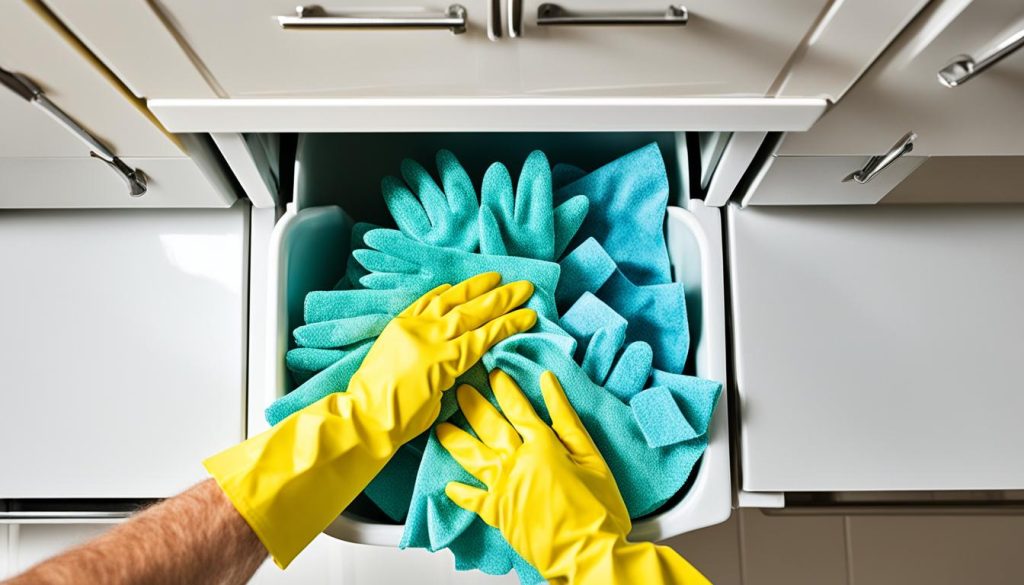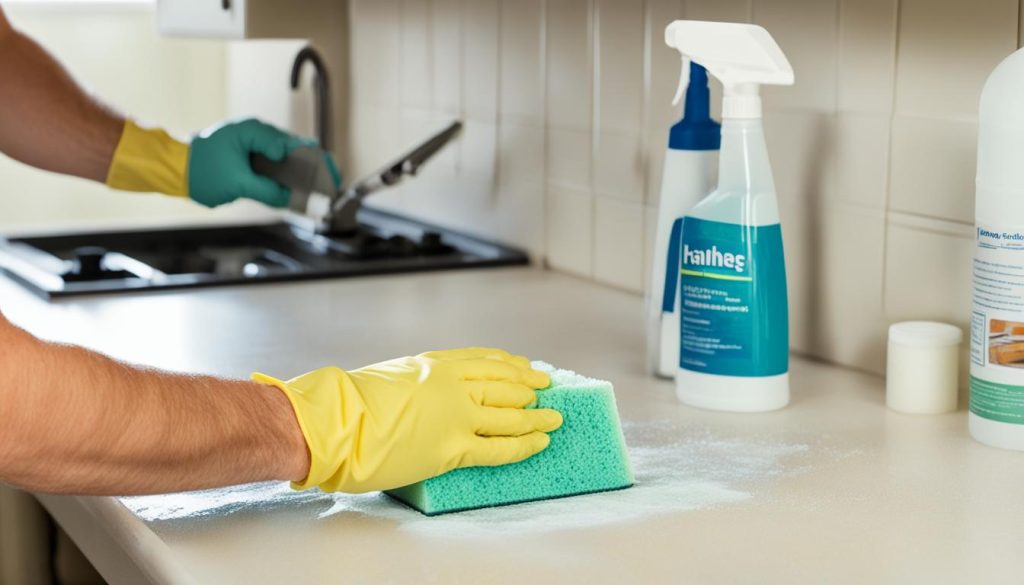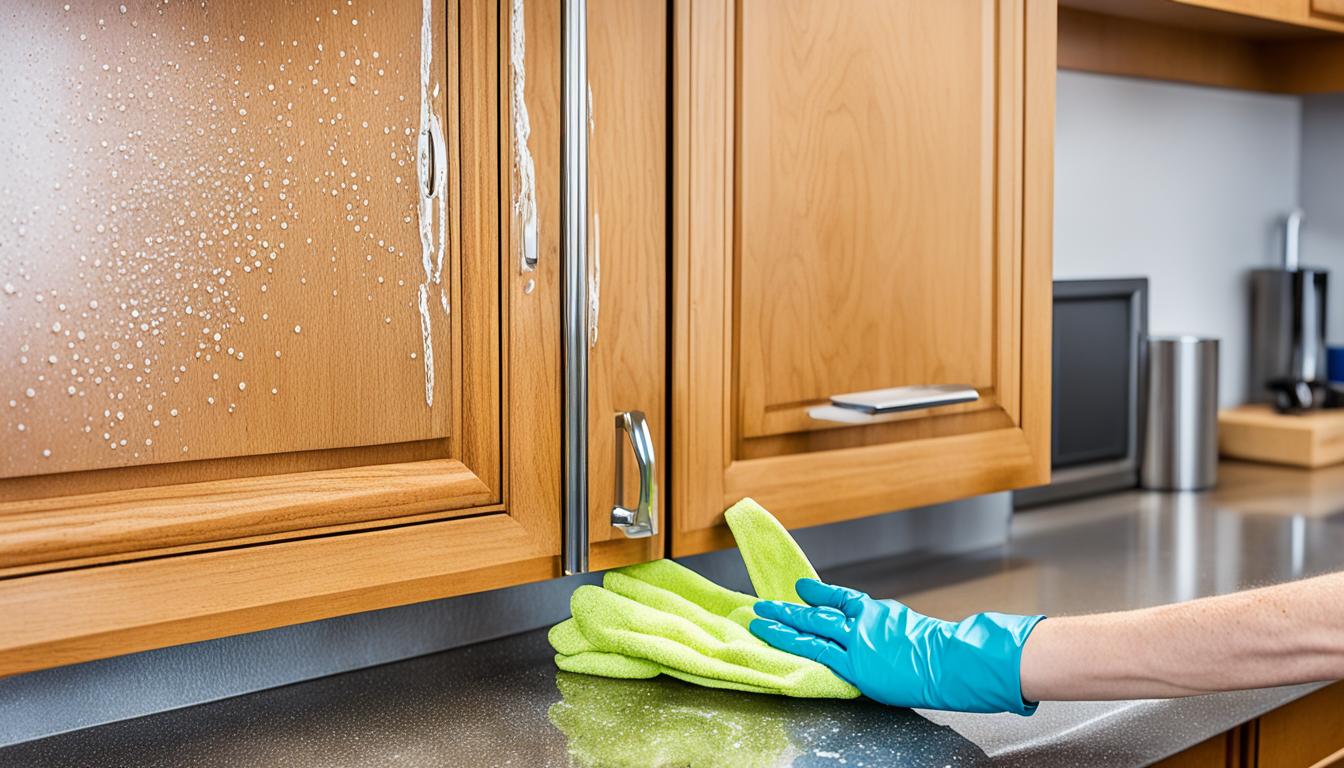Did you know that the average kitchen cabinet harbors over 1,000 bacteria per square inch? That’s more than a toilet seat! With such staggering statistics, it’s crucial to maintain clean and hygienic kitchen cabinets. In this article, I will share effective tips, tricks, and best practices for cleaning your kitchen cabinets, ensuring they shine and promote a healthy environment in your home.
Key Takeaways:
- Regular cleaning of kitchen cabinets is essential to remove dirt, grease, and bacteria buildup.
- Two eco-friendly cleaning methods, the 3 Cloth System and the Spray Bottle System, can effectively clean your cabinets without harsh chemicals.
- Essential cleaning supplies include a collapsible dishpan bucket, microfiber cloths, and natural cleaners like Sal Suds or Dawn dish soap.
- Follow a step-by-step guide to deep clean your kitchen cabinets, paying attention to both the exterior and interior surfaces.
- Maintain clean and sparkling cabinets by adopting practices like lining shelves, keeping doors closed, and using hardware to open cabinets.
Two Easy and Eco-Friendly Cleaning Methods for Kitchen Cabinets
When it comes to cleaning kitchen cabinets, there are two simple and eco-friendly methods that you can try. These methods use natural ingredients and DIY techniques to effectively clean your cabinets without the use of harsh chemicals. Not only are these methods safe for you and your family, but they are also gentle on your cabinets, helping to preserve their beauty and longevity.
The 3 Cloth System
The first method is the 3 Cloth System, which involves using two containers filled with soap and water, and three separate cloths. Here’s how it works:
- Fill one container with warm water and a few drops of gentle dish soap.
- Fill the second container with clean water for rinsing.
- Take the first cloth, dampen it in the soapy water, and use it to clean a cabinet, removing dirt, grease, and stains.
- Rinse the second cloth in the clean water and use it to thoroughly rinse the cabinet.
- Take the third cloth, dry it off, and use it to wipe down the cabinet, ensuring it is completely dry.
- Repeat these steps for each cabinet, changing the soapy water and rinsing water as needed.
The 3 Cloth System is a simple and effective way to clean your kitchen cabinets without causing any damage. It allows you to control the amount of moisture applied to each cabinet and ensures a thorough cleaning process.
The Spray Bottle System
The second method is the Spray Bottle System, which involves creating a cleaning solution using hot water and dish soap. Here’s how you can do it:
- Fill a spray bottle with hot water, leaving some space at the top.
- Add a few drops of gentle dish soap to the spray bottle.
- Close the spray bottle and shake it gently to mix the soap and water.
- Spray the cleaning solution onto a microfiber cloth.
- Wipe down the cabinets, focusing on areas with dirt, grease, and stains.
- Repeat the process as needed, ensuring all cabinets are thoroughly cleaned.
The Spray Bottle System is a convenient and efficient method for cleaning kitchen cabinets. The spray bottle allows you to control the amount of cleaning solution used, and the microfiber cloth is gentle on the cabinets while effectively removing grime and buildup.
Incorporating these DIY cabinet cleaning methods into your routine will not only keep your kitchen cabinets looking fresh and clean but also contribute to a healthier and more eco-friendly home.
| Method | Pros | Cons |
|---|---|---|
| 3 Cloth System |
|
|
| Spray Bottle System |
|
|
Essential Cleaning Supplies for Kitchen Cabinet Cleaning
When it comes to cleaning kitchen cabinets, having the right supplies can make all the difference. Here are some essential cleaning supplies that will help you achieve the best results and maintain clean and sparkling cabinets.
- A Collapsible Dishpan Bucket: This handy tool is perfect for easy and efficient cabinet cleaning. Its collapsible design makes it convenient to store and use, allowing you to tackle the task with ease.
- Microfiber Cloths: These soft and absorbent cloths are a must-have for cleaning cabinets. They are gentle on surfaces yet effective in removing dirt, dust, and grime without scratching or damaging the cabinet material.
- Natural Cleaners: Opt for natural cleaners like Sal Suds or Dawn dish soap. These eco-friendly options are powerful enough to cut through grease and grime but gentle on your cabinets.
Additionally, having glass spray bottles can be beneficial for making your own cleaning solutions. You can mix vinegar and water or other natural ingredients to create a DIY cleaner that is safe and effective for your cabinets.
In some instances, professional cabinet cleaning services may be an option if you prefer to leave the task to the experts. However, by using these DIY methods and essential cleaning supplies, you can maintain clean and sparkling cabinets on your own.

Step-by-Step Guide to Cleaning Kitchen Cabinets
Cleaning kitchen cabinets involves a step-by-step process that ensures a thorough and effective cleaning. Follow these simple steps to achieve spotless and well-maintained cabinets:
- Dust the cabinets: Start by removing any loose dirt and debris from the cabinets. Use a microfiber cloth or a feather duster to gently wipe away the dust.
- Mix a cleaning solution: Prepare a cleaning solution by mixing warm water and dish soap in a small bucket or bowl. If your cabinets are made of wood, you can also use a specialized cleaner like Murphy’s Oil Soap.
- Start cleaning: Dip a clean cloth or sponge into the cleaning solution and wring out the excess liquid. Begin wiping down the exterior of the cabinets, paying attention to any greasy or sticky spots. For painted cabinets, be gentle to avoid damaging the paint finish.
- Tackle stubborn stains: If you come across stubborn stains or marks on your cabinets, create a paste by mixing baking soda with water. Apply the paste to the stain, gently scrub in a circular motion, and then wipe away with a damp cloth.
- Clean the interior: Don’t forget to clean the inside of your cabinets as well. Remove all the contents and wipe down the shelves and drawers with the cleaning solution. This is also an excellent opportunity to declutter and organize your cabinets.
- Dry the cabinets: After cleaning, use a clean and dry cloth to wipe off any remaining moisture from the cabinets. Ensure that they are completely dry to prevent water damage or warping.
Regular deep cleaning of kitchen cabinets every few months will help maintain their cleanliness and extend their lifespan. Remember to use gentle cleaning methods and products suitable for the materials used in your cabinets to avoid any damage.

Tips for Maintaining Clean and Sparkling Cabinets
Now that you’ve put in the effort to clean your kitchen cabinets, it’s important to know how to maintain their cleanliness and keep them looking sparkling. By adopting a few simple maintenance tips, you can ensure that your cabinets stay in optimal condition for years to come.
One key tip for maintaining clean cabinets is to line the shelves. By using shelf liners, you can protect the surface from moisture and spills, making it easier to clean and preventing any damage. Additionally, keeping your cabinet doors closed when not in use can help minimize the accumulation of dust and debris, keeping your cabinets looking fresh.
When storing dishes and utensils in your cabinets, it’s crucial to make sure they are completely dry. Moisture can lead to the growth of mold and mildew, which can be harmful to both the cabinets and your health. By ensuring that everything is dry before putting it away, you can maintain a clean and hygienic environment.
Another best practice for maintaining clean cabinets is to use hardware to open them. Instead of touching the wood surfaces, which can transfer oils and dirt to the cabinet doors, consider installing handles or knobs. This simple change can help minimize the need for frequent cleaning and preserve the pristine appearance of your cabinets.
